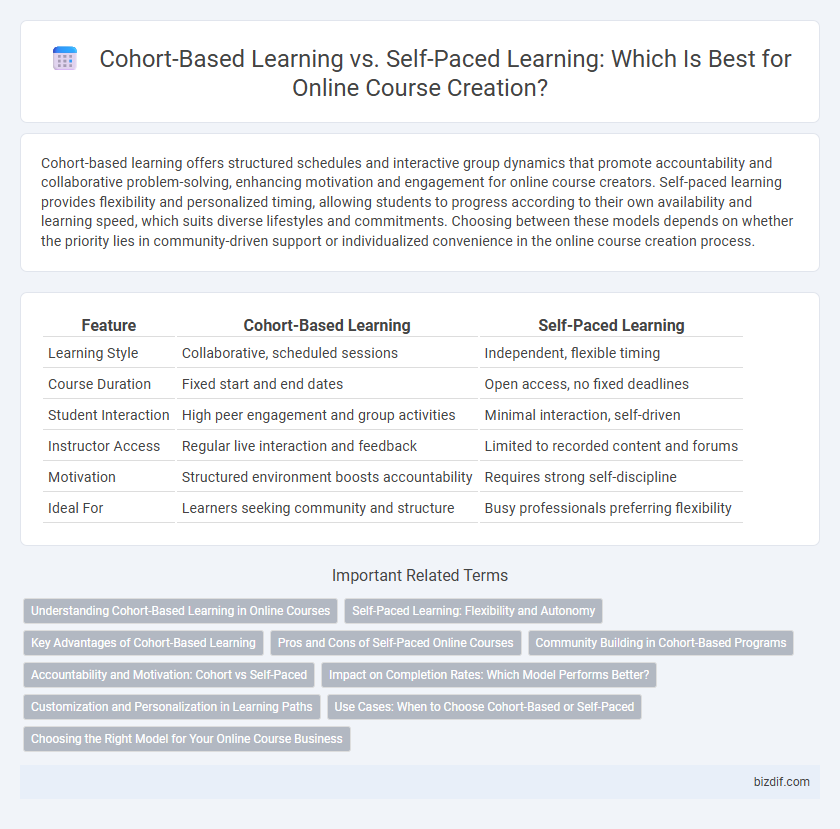Cohort-based learning offers structured schedules and interactive group dynamics that promote accountability and collaborative problem-solving, enhancing motivation and engagement for online course creators. Self-paced learning provides flexibility and personalized timing, allowing students to progress according to their own availability and learning speed, which suits diverse lifestyles and commitments. Choosing between these models depends on whether the priority lies in community-driven support or individualized convenience in the online course creation process.
Table of Comparison
| Feature | Cohort-Based Learning | Self-Paced Learning |
|---|---|---|
| Learning Style | Collaborative, scheduled sessions | Independent, flexible timing |
| Course Duration | Fixed start and end dates | Open access, no fixed deadlines |
| Student Interaction | High peer engagement and group activities | Minimal interaction, self-driven |
| Instructor Access | Regular live interaction and feedback | Limited to recorded content and forums |
| Motivation | Structured environment boosts accountability | Requires strong self-discipline |
| Ideal For | Learners seeking community and structure | Busy professionals preferring flexibility |
Understanding Cohort-Based Learning in Online Courses
Cohort-based learning in online courses fosters collaboration and accountability by enrolling students in groups that progress through the material simultaneously, enhancing engagement and motivation. This structured format leverages synchronous discussions, peer feedback, and scheduled deadlines to build a dynamic learning community. Research shows cohort-based models improve completion rates and knowledge retention compared to self-paced alternatives.
Self-Paced Learning: Flexibility and Autonomy
Self-paced learning offers unparalleled flexibility, allowing learners to access course materials anytime and progress at their own speed, which caters to varied schedules and learning styles. This format promotes autonomy, empowering individuals to take control of their education by customizing their study plans and focusing on topics that meet their personal or professional goals. Enhanced with multimedia resources and interactive elements, self-paced courses optimize engagement while accommodating diverse learner needs without the constraints of fixed timelines.
Key Advantages of Cohort-Based Learning
Cohort-based learning fosters increased engagement and motivation by creating a structured schedule and community interaction that drives accountability among participants. This method enhances collaborative skills through peer discussions, group projects, and real-time feedback, which are often missing in self-paced formats. Higher course completion rates and improved knowledge retention are common outcomes due to the social support and consistent pacing inherent in cohort-based learning environments.
Pros and Cons of Self-Paced Online Courses
Self-paced online courses offer unmatched flexibility, allowing learners to progress according to their individual schedules and learning speeds, ideal for diverse lifestyles and time constraints. However, these courses may lack immediate interaction and real-time feedback, leading to potential motivation challenges and lower completion rates compared to cohort-based models. Despite these drawbacks, self-paced courses provide scalable, cost-effective education solutions that accommodate a wide range of learners seeking autonomy.
Community Building in Cohort-Based Programs
Cohort-based learning fosters strong community building by encouraging real-time interaction, collaboration, and shared experiences among learners, which enhances engagement and motivation. In contrast, self-paced learning often lacks this sense of community, leading to isolation and reduced opportunities for peer support and networking. The structured schedule and group dynamics in cohort programs create a supportive environment that drives accountability and deeper knowledge retention.
Accountability and Motivation: Cohort vs Self-Paced
Cohort-based learning fosters accountability through scheduled interactions and peer support, which significantly boosts motivation and course completion rates. Self-paced learning offers flexibility but often lacks external accountability, leading to challenges in maintaining consistent motivation. Research shows cohort learners are 29% more likely to complete courses than self-paced students due to structured timelines and collaborative engagement.
Impact on Completion Rates: Which Model Performs Better?
Cohort-based learning typically yields higher completion rates due to structured schedules and peer accountability, fostering motivation and consistent progress. Self-paced learning offers flexibility but often faces lower completion rates as learners may struggle with procrastination or lack of support. Data from platforms like Coursera show cohort-based courses achieving completion rates of 60-80%, compared to 12-20% for self-paced models.
Customization and Personalization in Learning Paths
Cohort-based learning offers limited customization as all participants follow a fixed schedule and curriculum, fostering peer interaction but restricting individual pacing. Self-paced learning provides extensive personalization, allowing learners to tailor their progress and focus on specific topics according to their unique needs and goals. Personalized learning paths in self-paced courses enhance engagement and mastery by adapting content delivery to individual styles, whereas cohort models emphasize uniform progression with less flexibility.
Use Cases: When to Choose Cohort-Based or Self-Paced
Cohort-based learning is ideal for courses requiring peer interaction, structured deadlines, and collaborative projects, such as professional skill development or leadership training. Self-paced learning suits learners needing flexibility, personalized schedules, and asynchronous access, making it perfect for technical courses or test preparation. Selecting between these methods depends on learners' goals, time availability, and the importance of community engagement in the learning process.
Choosing the Right Model for Your Online Course Business
Cohort-based learning fosters engagement and accountability by guiding students through content simultaneously, ideal for courses requiring collaboration or intensive support. Self-paced learning offers flexibility and scalability, catering to learners who prefer autonomous study and varied schedules. Assess your target audience's preferences, course complexity, and business goals to determine whether structured interaction or independent progression maximizes learning outcomes and revenue potential.
Cohort-based learning vs Self-paced learning Infographic

 bizdif.com
bizdif.com